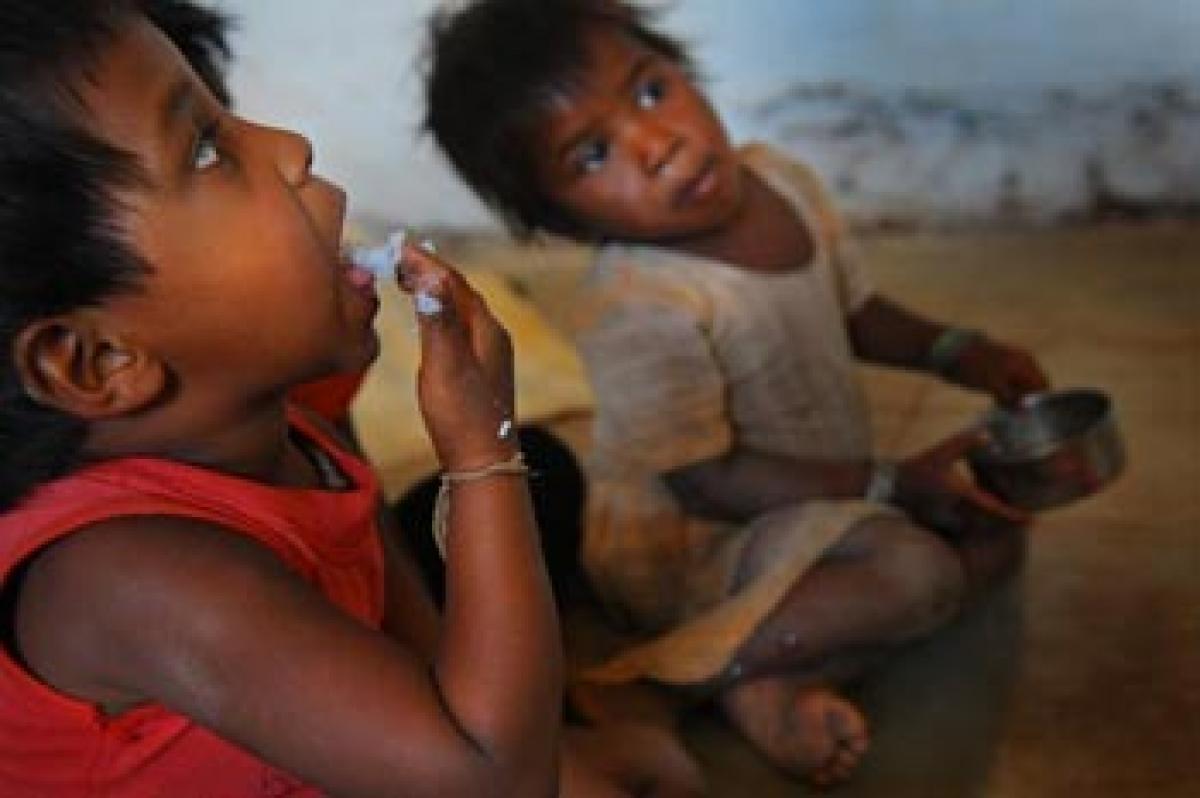Live
- Expose Opposition’s evil propaganda in villages: Seethakka to Cong workers
- MLA Sudhir focuses on amenities at Srikalahasti rly station
- Chittoor police crack down on drunk driving with 963 cases
- Vision document historical, says Keshav
- YSRCP to boycott elections to WUAs
- Farmers led by YSRCP leaders stage protest against graft
- MLA Dhanpal reminds Cong of promise of gold for brides
- Dy CM Pawan hails Swarna Andhra@2047 vision document
- Ensure success of Mathematic Talent exam
- Atchannaidu expresses concern over fall in tomato price
Just In

A high severity of malnutrition has marred the Telugu States of Andhra Pradesh and Telangana, according to the latest National Nutrition Monitoring Board Survey which found that 36.6% of children are underweight, while 44.7% of children have stunted growth or are retarded.
A high severity of malnutrition has marred the Telugu States of Andhra Pradesh and Telangana, according to the latest National Nutrition Monitoring Board Survey which found that 36.6% of children are underweight, while 44.7% of children have stunted growth or are retarded.
Around 12 per cent of children of the same age group are found to be severely stunted, meaning they have height which is more than three standard deviations less than the expected height for their age. Stunting rates remain persistently high among children in Telangana around a third, and 40% of the 12-year-old children. They exhibit signs of thinness (under-nutrition).
The Survey also found high rates of malnutrition among rural children at 39 per cent as against 31.1 per cent in urban areas. It shows that 44.7 per cent among the poorest children, 34.5 per cent among Adivasi children and 37.9 per cent among Dalit children are stunted.
Stunting is a consequence of and taken as a proxy for malnutrition. Data from the survey indicate that overall there has been some decrease (5%) in the prevalence of stunting among the children (irrespective of gender): 40% of 12-year-old children in the cohort were stunted in 2014 compared with 38% when they were 1-year-old in 2002.
While stunting rates remain high for girls (34%), there is a substantial reduction in stunting among boys (from 41% in 2002 to 32% in 2014). The percentage of severe stunting in rural areas in the two States is at 12.1 per cent as against 11.7 per cent in urban areas.
The data has revealed high malnutrition levels in the two States because, as per World Health Organisations’ (WHO) global database on child growth and malnutrition, a 30 to 39 per cent prevalence of stunting is an indicator of severity of malnutrition by prevalence.
As per the World Health Organisation norms, stunting is directly linked to antenatal and post delivery malnutrition. “Mother’s nutritional intake affects child’s growth. Nutritional intake should be strictly monitored during pregnancy. And post delivery, immunisation and breast-feeding along with adequate supplements should be followed.”
Forty three per cent of Indian children under the age of five are underweight, while 31 per cent of children worldwide or nearly a third of children, who are stunted, live in India. The study also reveals about 50 per cent of children from SC and STs are malnourished, in India.
The two States have fared poorly when it comes to other indicators of malnutrition, including wasting and underweight. As per the survey, 6 per cent of children below five years were found to be wasted or having weight that is more than three standard deviations less than the expected weight for their height. Also, 6.8 per cent of children from rural residences were found to be wasted as against 5.6 per cent among those from urban households.
Even in this category, Dalit children below five years were more malnutritioned with 7.3 per cent of them suffering from wasting. However, as per the WHO’s child database, 5 to 9 per cent prevalence of wasting is indicative of medium severity of malnutrition.
While there are a host of State-run programmes to improve child health, including the largest outreach programme of its kind in the world, which is Integrated Child Development Services (ICDS), under nutrition among children still continues to haunt Telangana and Andhra Pradesh, say public health experts.
It is found that there is lack of infrastructure in Aanganwadi centres in AP and TS, with regard to supplies and trained staff. There is also inappropriate focus of Aanganwadi workers that had a detrimental impact on the consistency or fidelity of the programme.
There are simply not enough Aanganwadi helpers and workers to staff existing Aanganwadi centres in TS and AP. In TS and AP, there are 6,718 Aanganwadi centres out of which 476 do not have workers while close to 600 do not have Aanganwadi helpers.
The study also suggests other findings that the food intake of poor children is changing. Children in both states are eating poorer quality of cereals and less pulses, legumes and nuts. Besides this, clean water and good sanitation is crucial for children’s healthy development and to reduce the burden of disease and malnutrition.

© 2024 Hyderabad Media House Limited/The Hans India. All rights reserved. Powered by hocalwire.com







